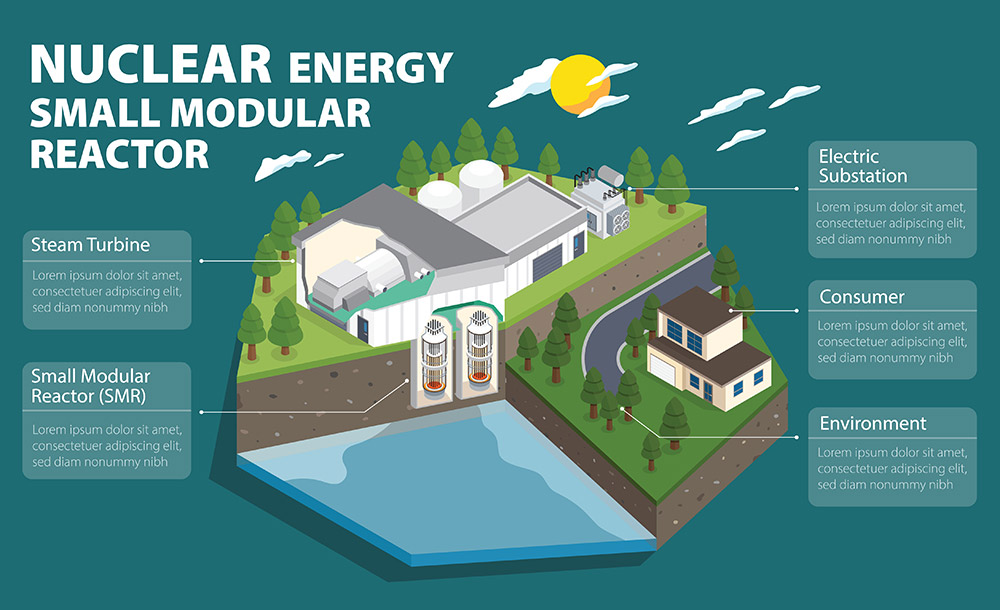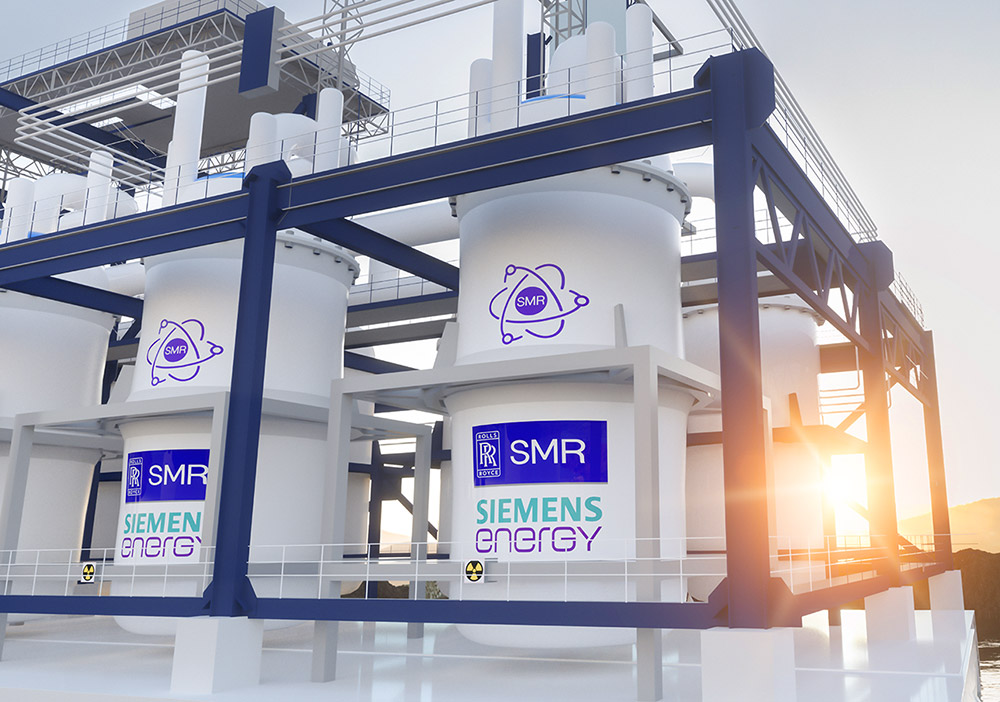Power drives site location. With the surge in hyperscalers across nearly every industry, energy demands have continued to increase, and alternative solutions have become increasingly attractive. There is heightened demand for cleaner energy options, and the nuclear energy industry is seeing renewed attention. There are a number of intriguing projects underway in the nuclear power sector — from restarting large, mothballed nuclear facilities to building smaller packaged nuclear facilities across the U.S. — options once considered infeasible are being explored anew.
The Nuances of Nuclear
Nuclear energy is reliable and highly capable. Nuclear energy currently generates 775 billion kWh annually and accounts for nearly 20 percent of all U.S. generation since the 1990s. Most U.S. nuclear power plants use light-water reactors, a type of nuclear reactor that uses water as the coolant and the neutron moderator, to produce around one gigawatt (1 GW) of power each.
The technology behind small modular reactors (SMRs) is similar to large, traditional reactors and has historically been used to power nuclear submarines. Innovation has taken that technology to the next level. Due to their smaller size, SMR modules can utilize readily available components and be scaled to meet specific energy demands. Additionally, added safety features allow for a smaller land footprint and require less on-site setup and maintenance.
Academic-Industry Collaberations Advancing Nuclear Research
Despite advances in technology and safety, reactor manufacturers have historically been unable to establish operations for clusters of modular nuclear reactors to supplement the energy grid. The acceleration in demand in order to power AI, data centers and other projects is seemingly insurmountable. A prime example is Texas. The state is projecting a need to nearly double its electrical capacity by 2031. This unprecedented stress on the power grid has opened the door for innovative public-private collaboration.
SMRs are one tool to close the energy gap, not the silver bullet.
Texas A&M recently announced a partnership with four small modular reactor companies — Kairos Power, Natura Resources, Terrestrial Energy, and Aalo Atomics — to build and test different styles of reactors at the RELLIS Innovation & Tech Campus. This “Energy Proving Ground” aims to generate “reliable, dispatchable power for the state” — with a goal to be operational by 2030 and potential capacity of 1 GW to start.
SMRs: a Potential Energy Solution
SMRs are a promising consideration in the alternative energy conversation, offering compact solutions for specific use cases. The development of small modular reactors (SMRs) could close the infrastructure gap and accelerate energy access to rural areas. The reactors require as little as 10 acres and can be co-located with manufacturing operations to provide a more sustainable energy package for projects. The versatility of SMR size and scale would allow utility companies to better adjust their electricity output of nuclear power to match demand. A single SMR could be a fit for projects with total power demands less than 300 MW, depending on the location. In comparison, a traditional nuclear power plant produces 800 MW of electricity or more.
The opportunity to co-locate power generation on manufacturing sites is a huge site selection advantage.
While promising, SMRs face significant challenges for large-scale applications. First, there have not yet been any SMRs manufactured in the U.S. to date. The Nuclear Regulatory Commission has approved the first SMR design for production, and Holtec and other industry leaders have set goals to manufacture and implement SMR technology by 2030. Second, the current timeline to deploy an SMR is three to four years, which is comparable to an electrical substation. A large, advanced manufacturing plant or data center can demand in excess of 500 MW at full operation, and hyperscalers demand multiple gigawatts. SMRs are cost-prohibitive in comparison to traditional substations for these high-energy-demand projects. Third, the SMR is one tool to close the energy gap, not the silver bullet. While SMRs are scalable and customizable, other solutions are necessary to meet the increasing and complex energy demands of the new economy. Recent federal tax legislation—the One Big Beautiful Bill Act, signed July 4, 2025—phases out most clean-energy credits like wind and solar, but importantly preserves technology-neutral production and investment credits, including those for new nuclear facilities and SMRs through at least 2033.
The Future Outlook for SMR Tschnology
The implementation of 300 SMRs could nearly double the U.S.’s nuclear power output. Beyond energy outputs, the construction and operation of nuclear reactor plants could generate hundreds of thousands of skilled jobs in the coming decades. The Nuclear Energy Institute estimates that up to 75 percent of the workforce for the fossil fuels industry could transfer to the nuclear power industry. A recent study by the Department of Energy found that more than 80 percent of retired and retiring coal sites in the U.S. are suitable for new advanced reactor technologies. These new technologies could potentially give a community a 92 percent increase in tax revenue and 650 more jobs over their former coal plant operations.
775B
Environmental considerations also present an uncertain outcome. Nuclear energy generates fewer carbon emissions than traditional energy sources; however, spent nuclear fuel requires isolation in deep-mined repositories for hundreds of thousands of years. Despite these potential limitations, this evolving industry is gaining momentum across all sectors and will undoubtedly impact long-term energy solutions as the technology advances and costs decrease.
Power Access As a Site Selection Driver
Electricity demands will continue to be a primary driver of future projects. Advancements in the AI and data center industries will continue to wear on the scarcity factor of the already-stressed electrical grid. It is essential to understand and anticipate the opportunity cost of available land and electric capacity and reliability to identify the top potential sites for a project.
Innovation has taken nuclear submarine technology to the next level for scalable land-based use.
Land near power stations, provided that capacity is reliable and scalable, is more valuable. Additionally, an opportunity to co-locate power generation on data center and manufacturing sites is a huge advantage for site selection projects.
State and community economic development organizations need to take a holistic approach to project pursuit, balancing the demand for high-power sites with highest-and-best-use considerations. As a prime example, communities may be drawn to proposing a rail-served site for a lucrative data center project because the infrastructure is readily available. However, strategic and long-term thinking may need to counteract that impulse, recognizing that the site is better suited for manufacturing operations that may benefit from growth opportunities provided by the cost-effective and efficient transportation options for raw materials and finished goods — options not needed by a data center operation.
Texas may need to double its electrical capacity by 2031 — and SMRs could help.
Navigating the Nuclear Option
As energy demands rapidly increase across sectors, particularly in data centers and advanced manufacturing, SMRs present a promising component in America's evolving energy portfolio. While facing challenges including regulatory hurdles, deployment timelines, and waste management concerns, these compact nuclear solutions offer a path toward reliable, low-carbon energy generation that complements traditional power infrastructure. The strategic implications for site selection professionals and economic developers are significant, with communities that proactively address these considerations potentially gaining a competitive advantage in attracting next-generation projects.
Looking toward 2030 and beyond, the energy landscape will likely feature a diversified approach that includes SMRs alongside traditional power sources and renewables. For businesses and communities alike, adapting to this new reality requires forward-thinking strategies that balance immediate energy needs with long-term sustainability goals, understanding that the nuclear option is not a complete solution but rather an important piece of the complex puzzle of powering our technological future.





